Organizational Change through Transformational Leadership
VerifiedAdded on 2020/05/11
|15
|3901
|69
AI Summary
The text explores leadership within Nestle, focusing on two predominant styles: transactional and transformational. Transactional leadership, characterized by task-oriented management, is shown to be less effective in fostering employee motivation compared to the more inspirational approach of transformational leadership. The latter, which emphasizes vision sharing and personal development, aligns with higher job satisfaction levels among employees. This study also examines how transformational leadership facilitates organizational change by engaging employees in decision-making processes, ultimately enhancing their commitment and performance within the company. By employing methodologies such as SWOT analysis, this examination provides insights into the strategic advantages of adopting transformational leadership to achieve both short-term objectives and long-term organizational growth.
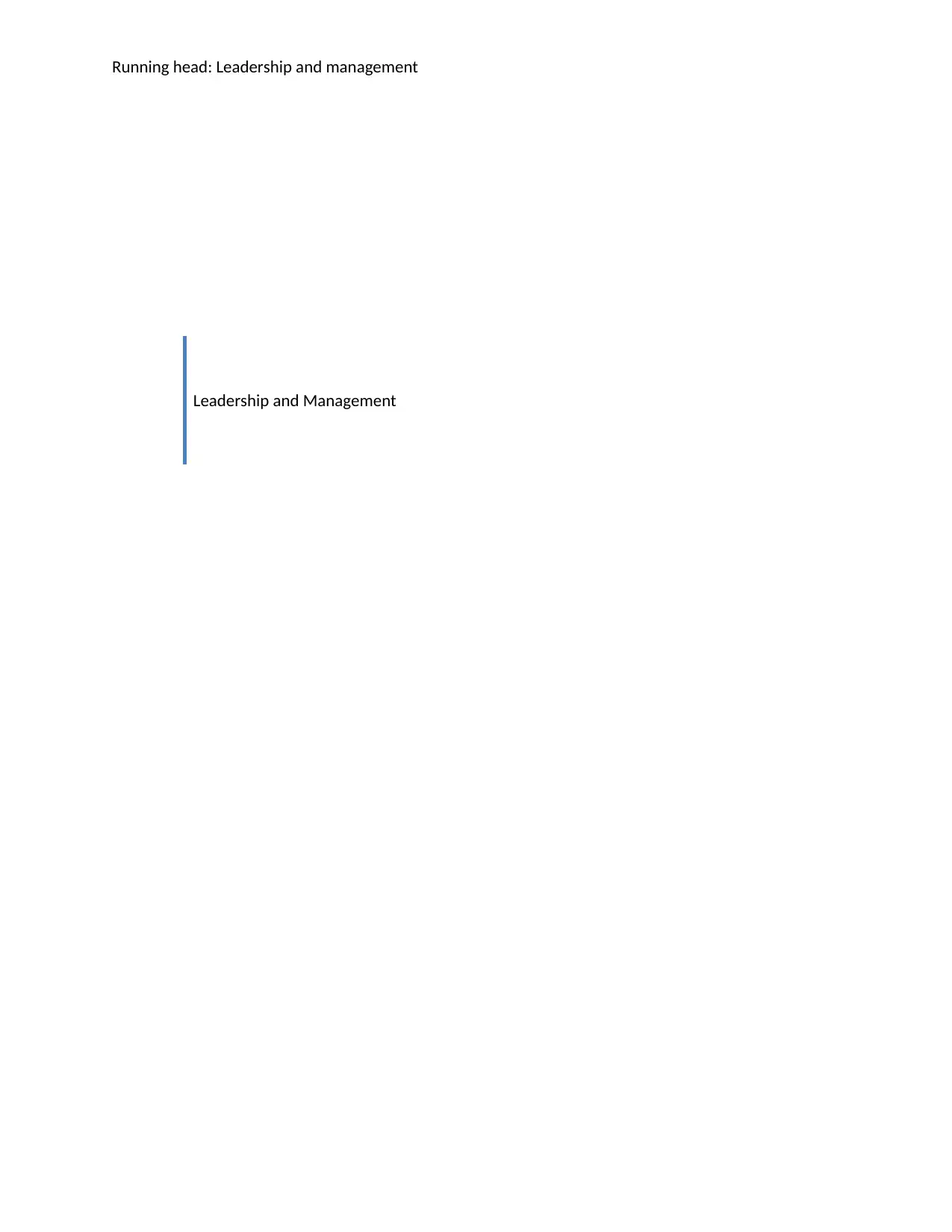
Running head: Leadership and management
Leadership and Management
Leadership and Management
Paraphrase This Document
Need a fresh take? Get an instant paraphrase of this document with our AI Paraphraser
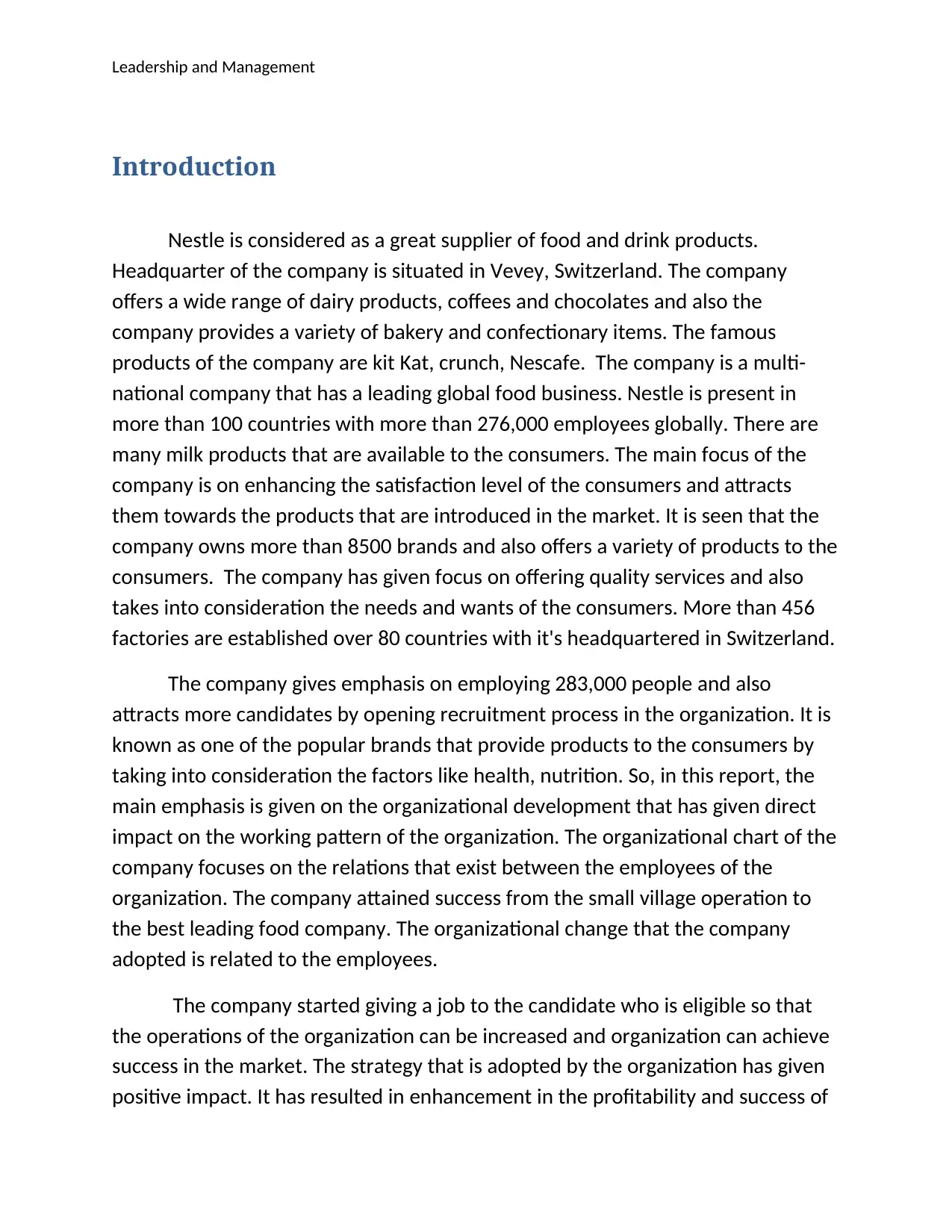
Leadership and Management
Introduction
Nestle is considered as a great supplier of food and drink products.
Headquarter of the company is situated in Vevey, Switzerland. The company
offers a wide range of dairy products, coffees and chocolates and also the
company provides a variety of bakery and confectionary items. The famous
products of the company are kit Kat, crunch, Nescafe. The company is a multi-
national company that has a leading global food business. Nestle is present in
more than 100 countries with more than 276,000 employees globally. There are
many milk products that are available to the consumers. The main focus of the
company is on enhancing the satisfaction level of the consumers and attracts
them towards the products that are introduced in the market. It is seen that the
company owns more than 8500 brands and also offers a variety of products to the
consumers. The company has given focus on offering quality services and also
takes into consideration the needs and wants of the consumers. More than 456
factories are established over 80 countries with it's headquartered in Switzerland.
The company gives emphasis on employing 283,000 people and also
attracts more candidates by opening recruitment process in the organization. It is
known as one of the popular brands that provide products to the consumers by
taking into consideration the factors like health, nutrition. So, in this report, the
main emphasis is given on the organizational development that has given direct
impact on the working pattern of the organization. The organizational chart of the
company focuses on the relations that exist between the employees of the
organization. The company attained success from the small village operation to
the best leading food company. The organizational change that the company
adopted is related to the employees.
The company started giving a job to the candidate who is eligible so that
the operations of the organization can be increased and organization can achieve
success in the market. The strategy that is adopted by the organization has given
positive impact. It has resulted in enhancement in the profitability and success of
Introduction
Nestle is considered as a great supplier of food and drink products.
Headquarter of the company is situated in Vevey, Switzerland. The company
offers a wide range of dairy products, coffees and chocolates and also the
company provides a variety of bakery and confectionary items. The famous
products of the company are kit Kat, crunch, Nescafe. The company is a multi-
national company that has a leading global food business. Nestle is present in
more than 100 countries with more than 276,000 employees globally. There are
many milk products that are available to the consumers. The main focus of the
company is on enhancing the satisfaction level of the consumers and attracts
them towards the products that are introduced in the market. It is seen that the
company owns more than 8500 brands and also offers a variety of products to the
consumers. The company has given focus on offering quality services and also
takes into consideration the needs and wants of the consumers. More than 456
factories are established over 80 countries with it's headquartered in Switzerland.
The company gives emphasis on employing 283,000 people and also
attracts more candidates by opening recruitment process in the organization. It is
known as one of the popular brands that provide products to the consumers by
taking into consideration the factors like health, nutrition. So, in this report, the
main emphasis is given on the organizational development that has given direct
impact on the working pattern of the organization. The organizational chart of the
company focuses on the relations that exist between the employees of the
organization. The company attained success from the small village operation to
the best leading food company. The organizational change that the company
adopted is related to the employees.
The company started giving a job to the candidate who is eligible so that
the operations of the organization can be increased and organization can achieve
success in the market. The strategy that is adopted by the organization has given
positive impact. It has resulted in enhancement in the profitability and success of
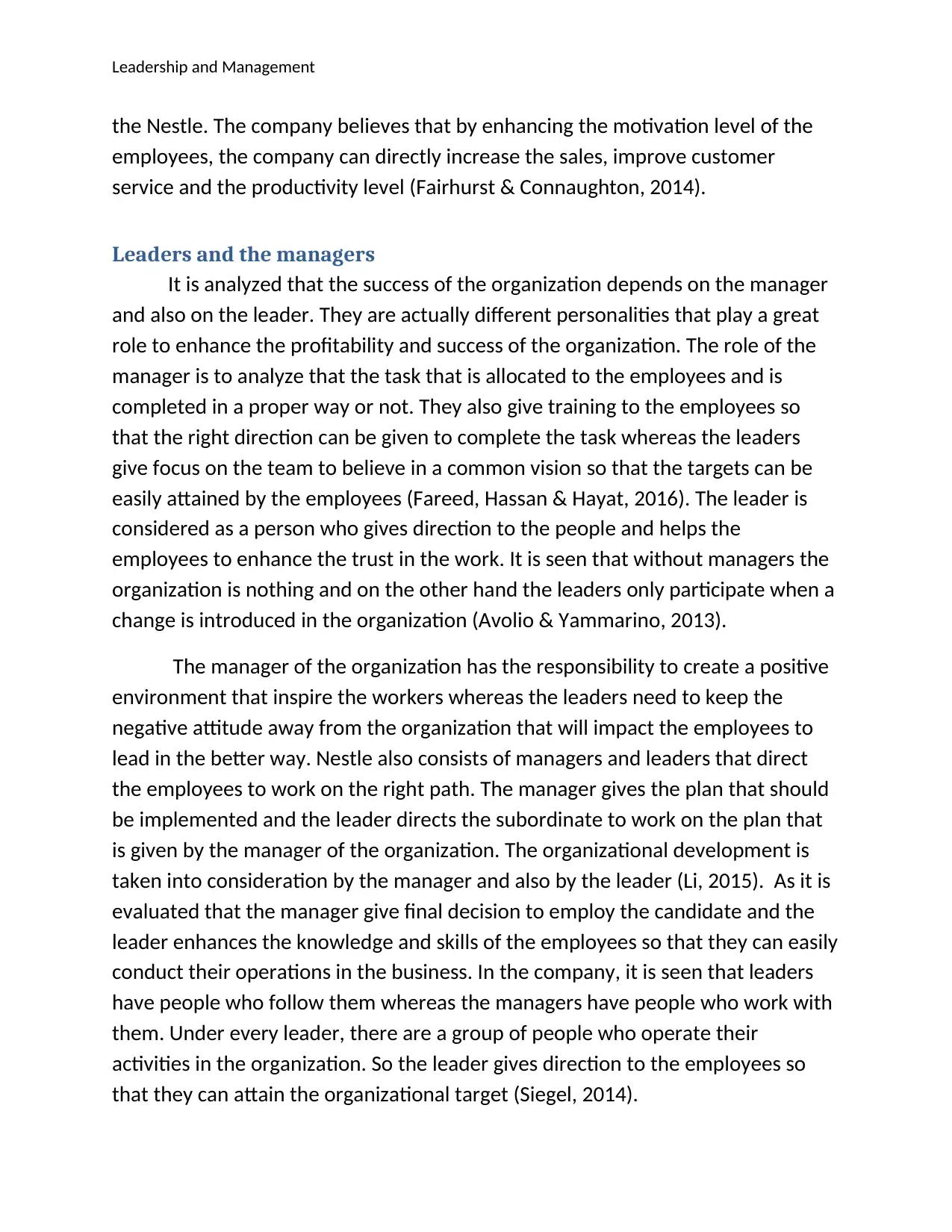
Leadership and Management
the Nestle. The company believes that by enhancing the motivation level of the
employees, the company can directly increase the sales, improve customer
service and the productivity level (Fairhurst & Connaughton, 2014).
Leaders and the managers
It is analyzed that the success of the organization depends on the manager
and also on the leader. They are actually different personalities that play a great
role to enhance the profitability and success of the organization. The role of the
manager is to analyze that the task that is allocated to the employees and is
completed in a proper way or not. They also give training to the employees so
that the right direction can be given to complete the task whereas the leaders
give focus on the team to believe in a common vision so that the targets can be
easily attained by the employees (Fareed, Hassan & Hayat, 2016). The leader is
considered as a person who gives direction to the people and helps the
employees to enhance the trust in the work. It is seen that without managers the
organization is nothing and on the other hand the leaders only participate when a
change is introduced in the organization (Avolio & Yammarino, 2013).
The manager of the organization has the responsibility to create a positive
environment that inspire the workers whereas the leaders need to keep the
negative attitude away from the organization that will impact the employees to
lead in the better way. Nestle also consists of managers and leaders that direct
the employees to work on the right path. The manager gives the plan that should
be implemented and the leader directs the subordinate to work on the plan that
is given by the manager of the organization. The organizational development is
taken into consideration by the manager and also by the leader (Li, 2015). As it is
evaluated that the manager give final decision to employ the candidate and the
leader enhances the knowledge and skills of the employees so that they can easily
conduct their operations in the business. In the company, it is seen that leaders
have people who follow them whereas the managers have people who work with
them. Under every leader, there are a group of people who operate their
activities in the organization. So the leader gives direction to the employees so
that they can attain the organizational target (Siegel, 2014).
the Nestle. The company believes that by enhancing the motivation level of the
employees, the company can directly increase the sales, improve customer
service and the productivity level (Fairhurst & Connaughton, 2014).
Leaders and the managers
It is analyzed that the success of the organization depends on the manager
and also on the leader. They are actually different personalities that play a great
role to enhance the profitability and success of the organization. The role of the
manager is to analyze that the task that is allocated to the employees and is
completed in a proper way or not. They also give training to the employees so
that the right direction can be given to complete the task whereas the leaders
give focus on the team to believe in a common vision so that the targets can be
easily attained by the employees (Fareed, Hassan & Hayat, 2016). The leader is
considered as a person who gives direction to the people and helps the
employees to enhance the trust in the work. It is seen that without managers the
organization is nothing and on the other hand the leaders only participate when a
change is introduced in the organization (Avolio & Yammarino, 2013).
The manager of the organization has the responsibility to create a positive
environment that inspire the workers whereas the leaders need to keep the
negative attitude away from the organization that will impact the employees to
lead in the better way. Nestle also consists of managers and leaders that direct
the employees to work on the right path. The manager gives the plan that should
be implemented and the leader directs the subordinate to work on the plan that
is given by the manager of the organization. The organizational development is
taken into consideration by the manager and also by the leader (Li, 2015). As it is
evaluated that the manager give final decision to employ the candidate and the
leader enhances the knowledge and skills of the employees so that they can easily
conduct their operations in the business. In the company, it is seen that leaders
have people who follow them whereas the managers have people who work with
them. Under every leader, there are a group of people who operate their
activities in the organization. So the leader gives direction to the employees so
that they can attain the organizational target (Siegel, 2014).
⊘ This is a preview!⊘
Do you want full access?
Subscribe today to unlock all pages.

Trusted by 1+ million students worldwide
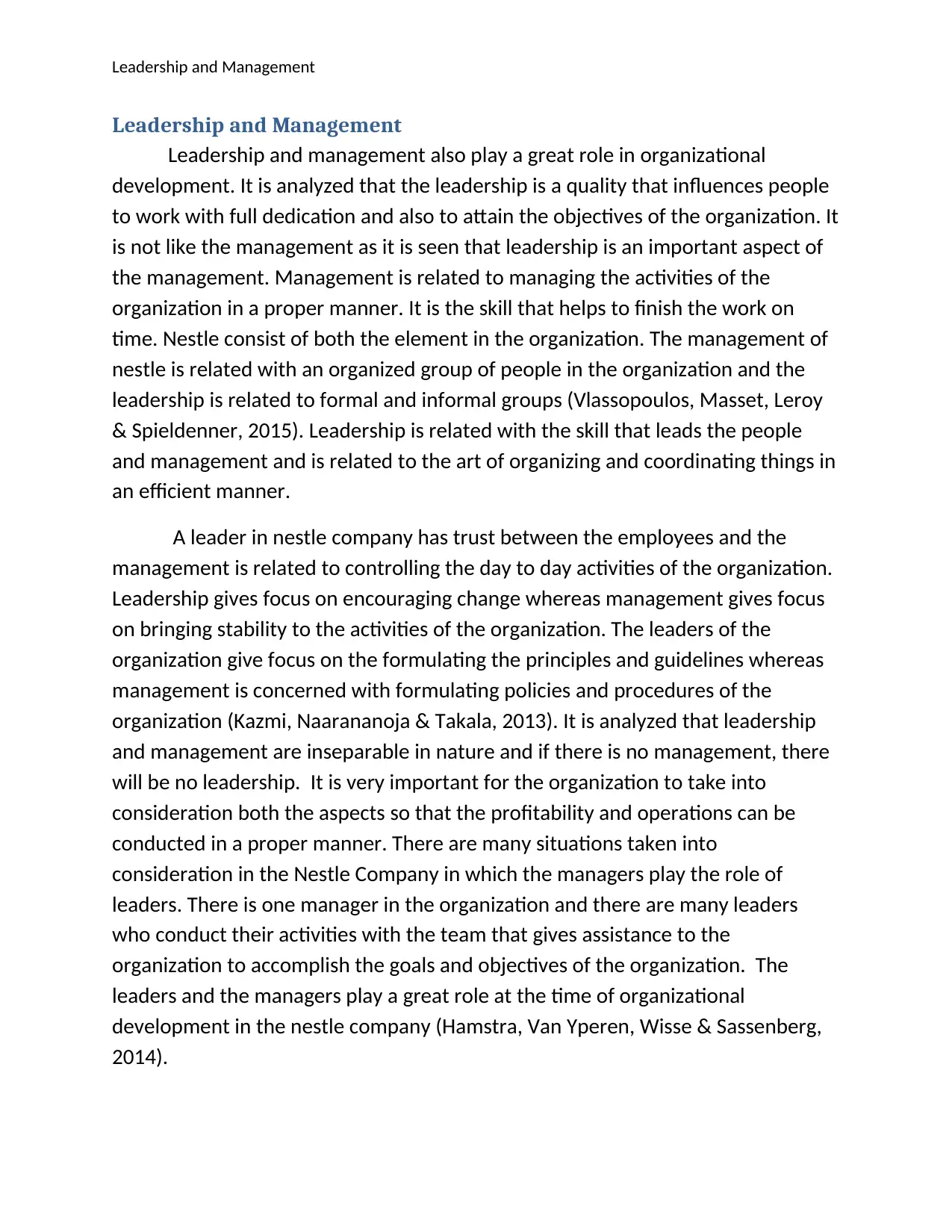
Leadership and Management
Leadership and Management
Leadership and management also play a great role in organizational
development. It is analyzed that the leadership is a quality that influences people
to work with full dedication and also to attain the objectives of the organization. It
is not like the management as it is seen that leadership is an important aspect of
the management. Management is related to managing the activities of the
organization in a proper manner. It is the skill that helps to finish the work on
time. Nestle consist of both the element in the organization. The management of
nestle is related with an organized group of people in the organization and the
leadership is related to formal and informal groups (Vlassopoulos, Masset, Leroy
& Spieldenner, 2015). Leadership is related with the skill that leads the people
and management and is related to the art of organizing and coordinating things in
an efficient manner.
A leader in nestle company has trust between the employees and the
management is related to controlling the day to day activities of the organization.
Leadership gives focus on encouraging change whereas management gives focus
on bringing stability to the activities of the organization. The leaders of the
organization give focus on the formulating the principles and guidelines whereas
management is concerned with formulating policies and procedures of the
organization (Kazmi, Naarananoja & Takala, 2013). It is analyzed that leadership
and management are inseparable in nature and if there is no management, there
will be no leadership. It is very important for the organization to take into
consideration both the aspects so that the profitability and operations can be
conducted in a proper manner. There are many situations taken into
consideration in the Nestle Company in which the managers play the role of
leaders. There is one manager in the organization and there are many leaders
who conduct their activities with the team that gives assistance to the
organization to accomplish the goals and objectives of the organization. The
leaders and the managers play a great role at the time of organizational
development in the nestle company (Hamstra, Van Yperen, Wisse & Sassenberg,
2014).
Leadership and Management
Leadership and management also play a great role in organizational
development. It is analyzed that the leadership is a quality that influences people
to work with full dedication and also to attain the objectives of the organization. It
is not like the management as it is seen that leadership is an important aspect of
the management. Management is related to managing the activities of the
organization in a proper manner. It is the skill that helps to finish the work on
time. Nestle consist of both the element in the organization. The management of
nestle is related with an organized group of people in the organization and the
leadership is related to formal and informal groups (Vlassopoulos, Masset, Leroy
& Spieldenner, 2015). Leadership is related with the skill that leads the people
and management and is related to the art of organizing and coordinating things in
an efficient manner.
A leader in nestle company has trust between the employees and the
management is related to controlling the day to day activities of the organization.
Leadership gives focus on encouraging change whereas management gives focus
on bringing stability to the activities of the organization. The leaders of the
organization give focus on the formulating the principles and guidelines whereas
management is concerned with formulating policies and procedures of the
organization (Kazmi, Naarananoja & Takala, 2013). It is analyzed that leadership
and management are inseparable in nature and if there is no management, there
will be no leadership. It is very important for the organization to take into
consideration both the aspects so that the profitability and operations can be
conducted in a proper manner. There are many situations taken into
consideration in the Nestle Company in which the managers play the role of
leaders. There is one manager in the organization and there are many leaders
who conduct their activities with the team that gives assistance to the
organization to accomplish the goals and objectives of the organization. The
leaders and the managers play a great role at the time of organizational
development in the nestle company (Hamstra, Van Yperen, Wisse & Sassenberg,
2014).
Paraphrase This Document
Need a fresh take? Get an instant paraphrase of this document with our AI Paraphraser
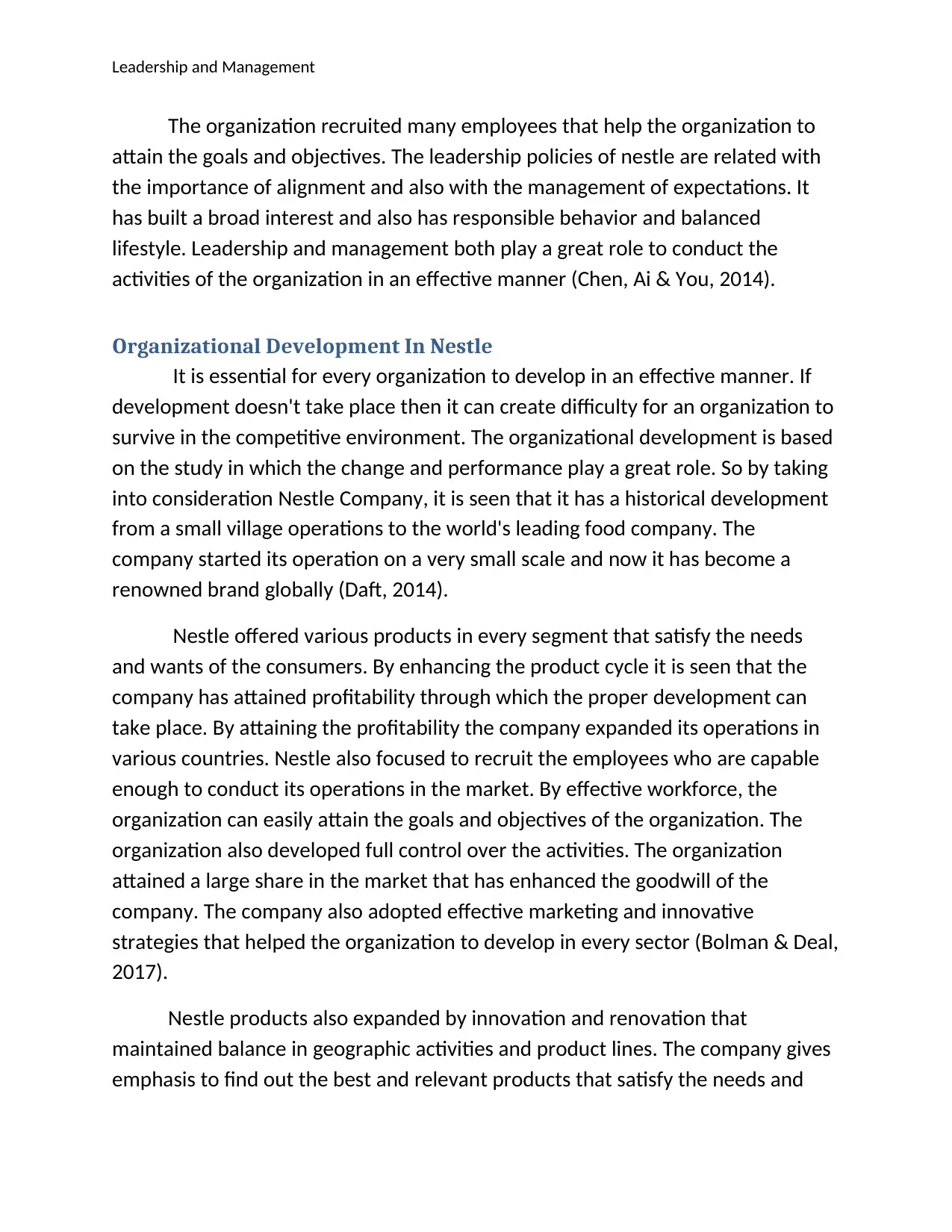
Leadership and Management
The organization recruited many employees that help the organization to
attain the goals and objectives. The leadership policies of nestle are related with
the importance of alignment and also with the management of expectations. It
has built a broad interest and also has responsible behavior and balanced
lifestyle. Leadership and management both play a great role to conduct the
activities of the organization in an effective manner (Chen, Ai & You, 2014).
Organizational Development In Nestle
It is essential for every organization to develop in an effective manner. If
development doesn't take place then it can create difficulty for an organization to
survive in the competitive environment. The organizational development is based
on the study in which the change and performance play a great role. So by taking
into consideration Nestle Company, it is seen that it has a historical development
from a small village operations to the world's leading food company. The
company started its operation on a very small scale and now it has become a
renowned brand globally (Daft, 2014).
Nestle offered various products in every segment that satisfy the needs
and wants of the consumers. By enhancing the product cycle it is seen that the
company has attained profitability through which the proper development can
take place. By attaining the profitability the company expanded its operations in
various countries. Nestle also focused to recruit the employees who are capable
enough to conduct its operations in the market. By effective workforce, the
organization can easily attain the goals and objectives of the organization. The
organization also developed full control over the activities. The organization
attained a large share in the market that has enhanced the goodwill of the
company. The company also adopted effective marketing and innovative
strategies that helped the organization to develop in every sector (Bolman & Deal,
2017).
Nestle products also expanded by innovation and renovation that
maintained balance in geographic activities and product lines. The company gives
emphasis to find out the best and relevant products that satisfy the needs and
The organization recruited many employees that help the organization to
attain the goals and objectives. The leadership policies of nestle are related with
the importance of alignment and also with the management of expectations. It
has built a broad interest and also has responsible behavior and balanced
lifestyle. Leadership and management both play a great role to conduct the
activities of the organization in an effective manner (Chen, Ai & You, 2014).
Organizational Development In Nestle
It is essential for every organization to develop in an effective manner. If
development doesn't take place then it can create difficulty for an organization to
survive in the competitive environment. The organizational development is based
on the study in which the change and performance play a great role. So by taking
into consideration Nestle Company, it is seen that it has a historical development
from a small village operations to the world's leading food company. The
company started its operation on a very small scale and now it has become a
renowned brand globally (Daft, 2014).
Nestle offered various products in every segment that satisfy the needs
and wants of the consumers. By enhancing the product cycle it is seen that the
company has attained profitability through which the proper development can
take place. By attaining the profitability the company expanded its operations in
various countries. Nestle also focused to recruit the employees who are capable
enough to conduct its operations in the market. By effective workforce, the
organization can easily attain the goals and objectives of the organization. The
organization also developed full control over the activities. The organization
attained a large share in the market that has enhanced the goodwill of the
company. The company also adopted effective marketing and innovative
strategies that helped the organization to develop in every sector (Bolman & Deal,
2017).
Nestle products also expanded by innovation and renovation that
maintained balance in geographic activities and product lines. The company gives
emphasis to find out the best and relevant products that satisfy the needs and
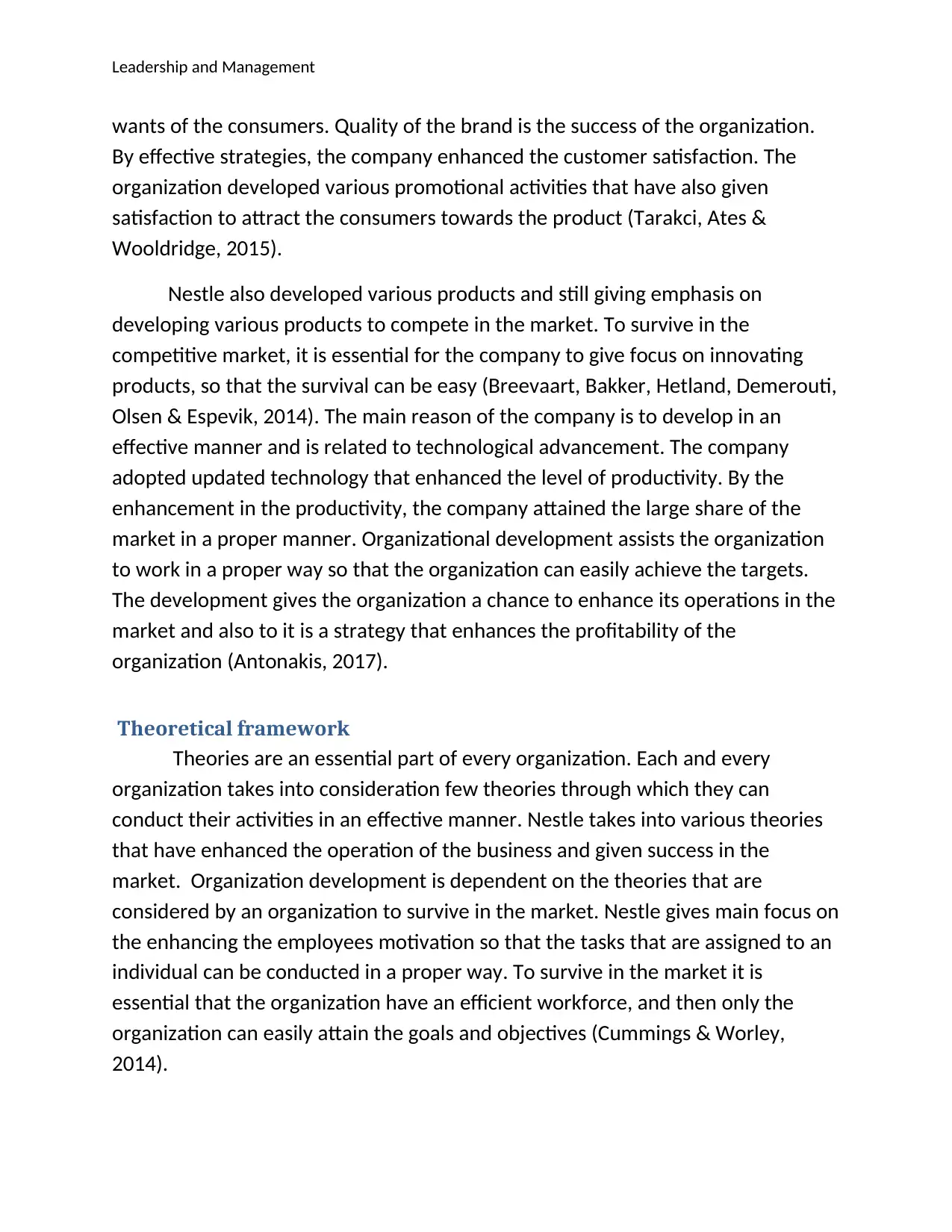
Leadership and Management
wants of the consumers. Quality of the brand is the success of the organization.
By effective strategies, the company enhanced the customer satisfaction. The
organization developed various promotional activities that have also given
satisfaction to attract the consumers towards the product (Tarakci, Ates &
Wooldridge, 2015).
Nestle also developed various products and still giving emphasis on
developing various products to compete in the market. To survive in the
competitive market, it is essential for the company to give focus on innovating
products, so that the survival can be easy (Breevaart, Bakker, Hetland, Demerouti,
Olsen & Espevik, 2014). The main reason of the company is to develop in an
effective manner and is related to technological advancement. The company
adopted updated technology that enhanced the level of productivity. By the
enhancement in the productivity, the company attained the large share of the
market in a proper manner. Organizational development assists the organization
to work in a proper way so that the organization can easily achieve the targets.
The development gives the organization a chance to enhance its operations in the
market and also to it is a strategy that enhances the profitability of the
organization (Antonakis, 2017).
Theoretical framework
Theories are an essential part of every organization. Each and every
organization takes into consideration few theories through which they can
conduct their activities in an effective manner. Nestle takes into various theories
that have enhanced the operation of the business and given success in the
market. Organization development is dependent on the theories that are
considered by an organization to survive in the market. Nestle gives main focus on
the enhancing the employees motivation so that the tasks that are assigned to an
individual can be conducted in a proper way. To survive in the market it is
essential that the organization have an efficient workforce, and then only the
organization can easily attain the goals and objectives (Cummings & Worley,
2014).
wants of the consumers. Quality of the brand is the success of the organization.
By effective strategies, the company enhanced the customer satisfaction. The
organization developed various promotional activities that have also given
satisfaction to attract the consumers towards the product (Tarakci, Ates &
Wooldridge, 2015).
Nestle also developed various products and still giving emphasis on
developing various products to compete in the market. To survive in the
competitive market, it is essential for the company to give focus on innovating
products, so that the survival can be easy (Breevaart, Bakker, Hetland, Demerouti,
Olsen & Espevik, 2014). The main reason of the company is to develop in an
effective manner and is related to technological advancement. The company
adopted updated technology that enhanced the level of productivity. By the
enhancement in the productivity, the company attained the large share of the
market in a proper manner. Organizational development assists the organization
to work in a proper way so that the organization can easily achieve the targets.
The development gives the organization a chance to enhance its operations in the
market and also to it is a strategy that enhances the profitability of the
organization (Antonakis, 2017).
Theoretical framework
Theories are an essential part of every organization. Each and every
organization takes into consideration few theories through which they can
conduct their activities in an effective manner. Nestle takes into various theories
that have enhanced the operation of the business and given success in the
market. Organization development is dependent on the theories that are
considered by an organization to survive in the market. Nestle gives main focus on
the enhancing the employees motivation so that the tasks that are assigned to an
individual can be conducted in a proper way. To survive in the market it is
essential that the organization have an efficient workforce, and then only the
organization can easily attain the goals and objectives (Cummings & Worley,
2014).
⊘ This is a preview!⊘
Do you want full access?
Subscribe today to unlock all pages.

Trusted by 1+ million students worldwide
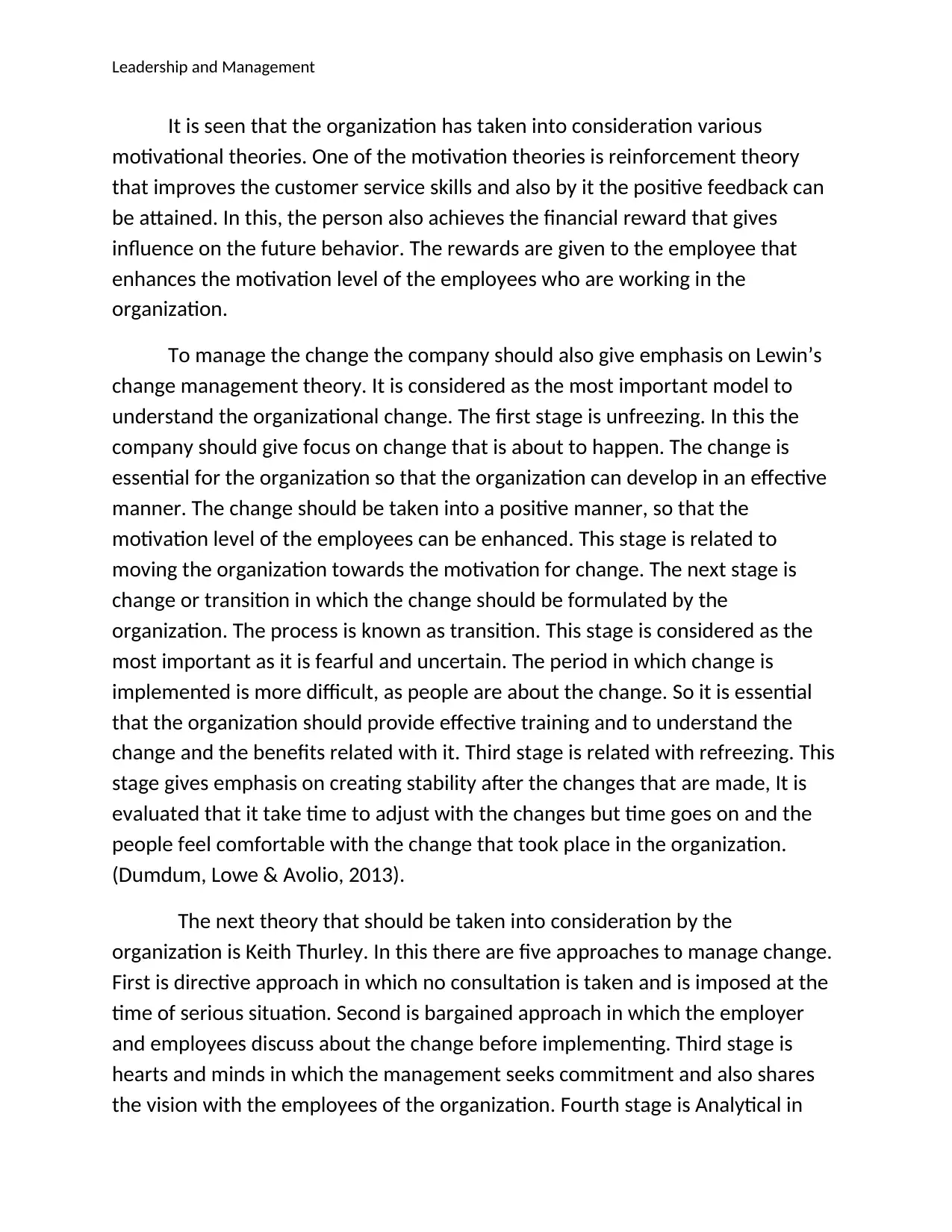
Leadership and Management
It is seen that the organization has taken into consideration various
motivational theories. One of the motivation theories is reinforcement theory
that improves the customer service skills and also by it the positive feedback can
be attained. In this, the person also achieves the financial reward that gives
influence on the future behavior. The rewards are given to the employee that
enhances the motivation level of the employees who are working in the
organization.
To manage the change the company should also give emphasis on Lewin’s
change management theory. It is considered as the most important model to
understand the organizational change. The first stage is unfreezing. In this the
company should give focus on change that is about to happen. The change is
essential for the organization so that the organization can develop in an effective
manner. The change should be taken into a positive manner, so that the
motivation level of the employees can be enhanced. This stage is related to
moving the organization towards the motivation for change. The next stage is
change or transition in which the change should be formulated by the
organization. The process is known as transition. This stage is considered as the
most important as it is fearful and uncertain. The period in which change is
implemented is more difficult, as people are about the change. So it is essential
that the organization should provide effective training and to understand the
change and the benefits related with it. Third stage is related with refreezing. This
stage gives emphasis on creating stability after the changes that are made, It is
evaluated that it take time to adjust with the changes but time goes on and the
people feel comfortable with the change that took place in the organization.
(Dumdum, Lowe & Avolio, 2013).
The next theory that should be taken into consideration by the
organization is Keith Thurley. In this there are five approaches to manage change.
First is directive approach in which no consultation is taken and is imposed at the
time of serious situation. Second is bargained approach in which the employer
and employees discuss about the change before implementing. Third stage is
hearts and minds in which the management seeks commitment and also shares
the vision with the employees of the organization. Fourth stage is Analytical in
It is seen that the organization has taken into consideration various
motivational theories. One of the motivation theories is reinforcement theory
that improves the customer service skills and also by it the positive feedback can
be attained. In this, the person also achieves the financial reward that gives
influence on the future behavior. The rewards are given to the employee that
enhances the motivation level of the employees who are working in the
organization.
To manage the change the company should also give emphasis on Lewin’s
change management theory. It is considered as the most important model to
understand the organizational change. The first stage is unfreezing. In this the
company should give focus on change that is about to happen. The change is
essential for the organization so that the organization can develop in an effective
manner. The change should be taken into a positive manner, so that the
motivation level of the employees can be enhanced. This stage is related to
moving the organization towards the motivation for change. The next stage is
change or transition in which the change should be formulated by the
organization. The process is known as transition. This stage is considered as the
most important as it is fearful and uncertain. The period in which change is
implemented is more difficult, as people are about the change. So it is essential
that the organization should provide effective training and to understand the
change and the benefits related with it. Third stage is related with refreezing. This
stage gives emphasis on creating stability after the changes that are made, It is
evaluated that it take time to adjust with the changes but time goes on and the
people feel comfortable with the change that took place in the organization.
(Dumdum, Lowe & Avolio, 2013).
The next theory that should be taken into consideration by the
organization is Keith Thurley. In this there are five approaches to manage change.
First is directive approach in which no consultation is taken and is imposed at the
time of serious situation. Second is bargained approach in which the employer
and employees discuss about the change before implementing. Third stage is
hearts and minds in which the management seeks commitment and also shares
the vision with the employees of the organization. Fourth stage is Analytical in
Paraphrase This Document
Need a fresh take? Get an instant paraphrase of this document with our AI Paraphraser
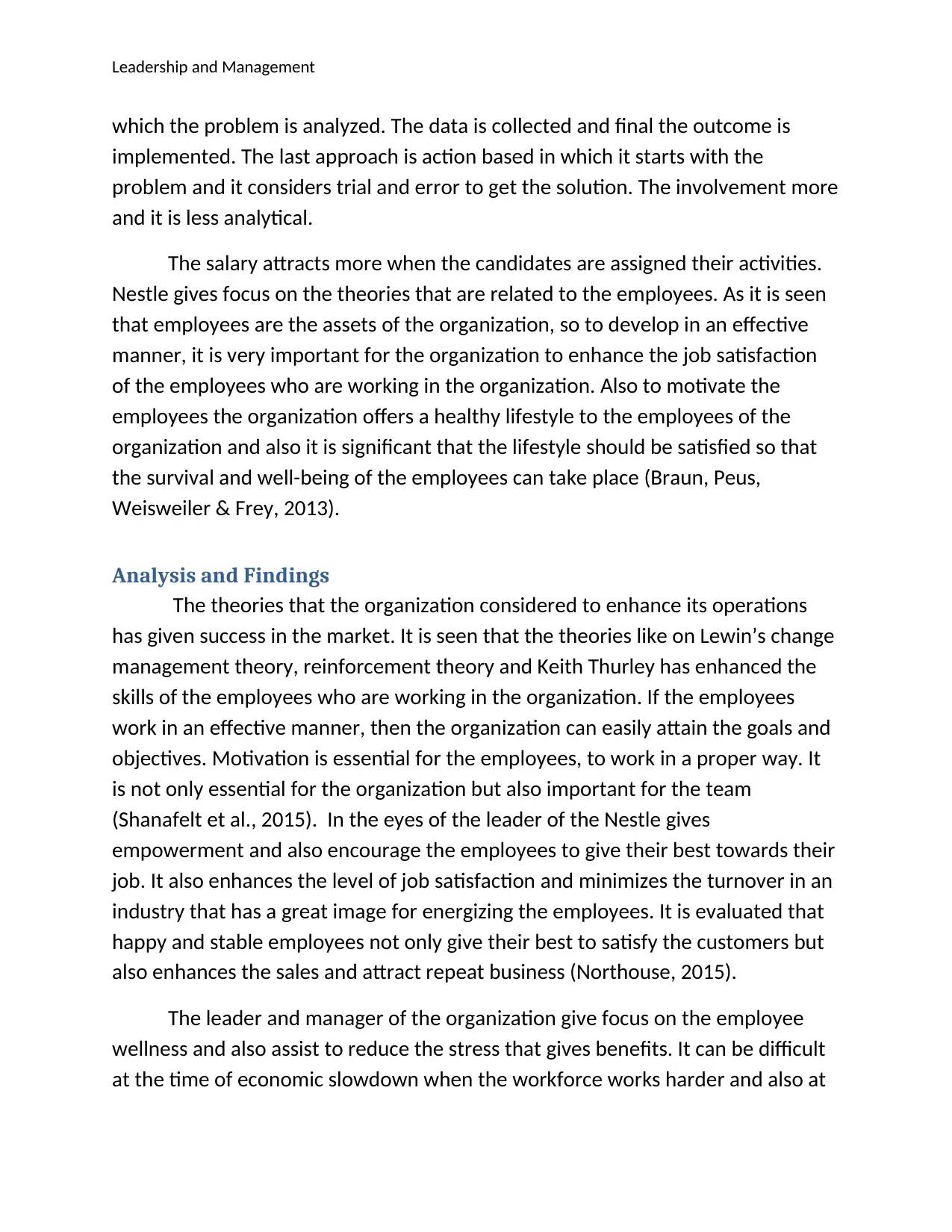
Leadership and Management
which the problem is analyzed. The data is collected and final the outcome is
implemented. The last approach is action based in which it starts with the
problem and it considers trial and error to get the solution. The involvement more
and it is less analytical.
The salary attracts more when the candidates are assigned their activities.
Nestle gives focus on the theories that are related to the employees. As it is seen
that employees are the assets of the organization, so to develop in an effective
manner, it is very important for the organization to enhance the job satisfaction
of the employees who are working in the organization. Also to motivate the
employees the organization offers a healthy lifestyle to the employees of the
organization and also it is significant that the lifestyle should be satisfied so that
the survival and well-being of the employees can take place (Braun, Peus,
Weisweiler & Frey, 2013).
Analysis and Findings
The theories that the organization considered to enhance its operations
has given success in the market. It is seen that the theories like on Lewin’s change
management theory, reinforcement theory and Keith Thurley has enhanced the
skills of the employees who are working in the organization. If the employees
work in an effective manner, then the organization can easily attain the goals and
objectives. Motivation is essential for the employees, to work in a proper way. It
is not only essential for the organization but also important for the team
(Shanafelt et al., 2015). In the eyes of the leader of the Nestle gives
empowerment and also encourage the employees to give their best towards their
job. It also enhances the level of job satisfaction and minimizes the turnover in an
industry that has a great image for energizing the employees. It is evaluated that
happy and stable employees not only give their best to satisfy the customers but
also enhances the sales and attract repeat business (Northouse, 2015).
The leader and manager of the organization give focus on the employee
wellness and also assist to reduce the stress that gives benefits. It can be difficult
at the time of economic slowdown when the workforce works harder and also at
which the problem is analyzed. The data is collected and final the outcome is
implemented. The last approach is action based in which it starts with the
problem and it considers trial and error to get the solution. The involvement more
and it is less analytical.
The salary attracts more when the candidates are assigned their activities.
Nestle gives focus on the theories that are related to the employees. As it is seen
that employees are the assets of the organization, so to develop in an effective
manner, it is very important for the organization to enhance the job satisfaction
of the employees who are working in the organization. Also to motivate the
employees the organization offers a healthy lifestyle to the employees of the
organization and also it is significant that the lifestyle should be satisfied so that
the survival and well-being of the employees can take place (Braun, Peus,
Weisweiler & Frey, 2013).
Analysis and Findings
The theories that the organization considered to enhance its operations
has given success in the market. It is seen that the theories like on Lewin’s change
management theory, reinforcement theory and Keith Thurley has enhanced the
skills of the employees who are working in the organization. If the employees
work in an effective manner, then the organization can easily attain the goals and
objectives. Motivation is essential for the employees, to work in a proper way. It
is not only essential for the organization but also important for the team
(Shanafelt et al., 2015). In the eyes of the leader of the Nestle gives
empowerment and also encourage the employees to give their best towards their
job. It also enhances the level of job satisfaction and minimizes the turnover in an
industry that has a great image for energizing the employees. It is evaluated that
happy and stable employees not only give their best to satisfy the customers but
also enhances the sales and attract repeat business (Northouse, 2015).
The leader and manager of the organization give focus on the employee
wellness and also assist to reduce the stress that gives benefits. It can be difficult
at the time of economic slowdown when the workforce works harder and also at
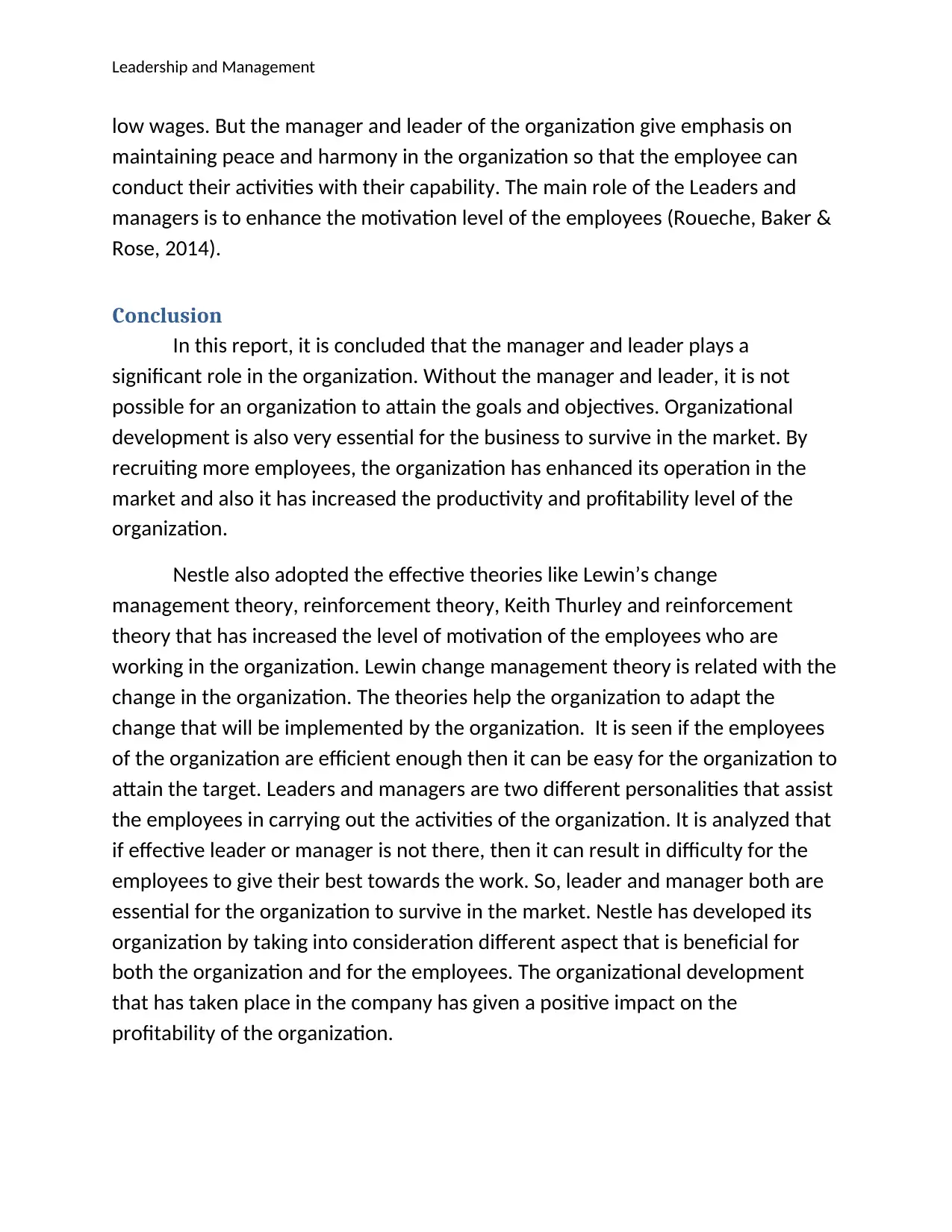
Leadership and Management
low wages. But the manager and leader of the organization give emphasis on
maintaining peace and harmony in the organization so that the employee can
conduct their activities with their capability. The main role of the Leaders and
managers is to enhance the motivation level of the employees (Roueche, Baker &
Rose, 2014).
Conclusion
In this report, it is concluded that the manager and leader plays a
significant role in the organization. Without the manager and leader, it is not
possible for an organization to attain the goals and objectives. Organizational
development is also very essential for the business to survive in the market. By
recruiting more employees, the organization has enhanced its operation in the
market and also it has increased the productivity and profitability level of the
organization.
Nestle also adopted the effective theories like Lewin’s change
management theory, reinforcement theory, Keith Thurley and reinforcement
theory that has increased the level of motivation of the employees who are
working in the organization. Lewin change management theory is related with the
change in the organization. The theories help the organization to adapt the
change that will be implemented by the organization. It is seen if the employees
of the organization are efficient enough then it can be easy for the organization to
attain the target. Leaders and managers are two different personalities that assist
the employees in carrying out the activities of the organization. It is analyzed that
if effective leader or manager is not there, then it can result in difficulty for the
employees to give their best towards the work. So, leader and manager both are
essential for the organization to survive in the market. Nestle has developed its
organization by taking into consideration different aspect that is beneficial for
both the organization and for the employees. The organizational development
that has taken place in the company has given a positive impact on the
profitability of the organization.
low wages. But the manager and leader of the organization give emphasis on
maintaining peace and harmony in the organization so that the employee can
conduct their activities with their capability. The main role of the Leaders and
managers is to enhance the motivation level of the employees (Roueche, Baker &
Rose, 2014).
Conclusion
In this report, it is concluded that the manager and leader plays a
significant role in the organization. Without the manager and leader, it is not
possible for an organization to attain the goals and objectives. Organizational
development is also very essential for the business to survive in the market. By
recruiting more employees, the organization has enhanced its operation in the
market and also it has increased the productivity and profitability level of the
organization.
Nestle also adopted the effective theories like Lewin’s change
management theory, reinforcement theory, Keith Thurley and reinforcement
theory that has increased the level of motivation of the employees who are
working in the organization. Lewin change management theory is related with the
change in the organization. The theories help the organization to adapt the
change that will be implemented by the organization. It is seen if the employees
of the organization are efficient enough then it can be easy for the organization to
attain the target. Leaders and managers are two different personalities that assist
the employees in carrying out the activities of the organization. It is analyzed that
if effective leader or manager is not there, then it can result in difficulty for the
employees to give their best towards the work. So, leader and manager both are
essential for the organization to survive in the market. Nestle has developed its
organization by taking into consideration different aspect that is beneficial for
both the organization and for the employees. The organizational development
that has taken place in the company has given a positive impact on the
profitability of the organization.
⊘ This is a preview!⊘
Do you want full access?
Subscribe today to unlock all pages.

Trusted by 1+ million students worldwide
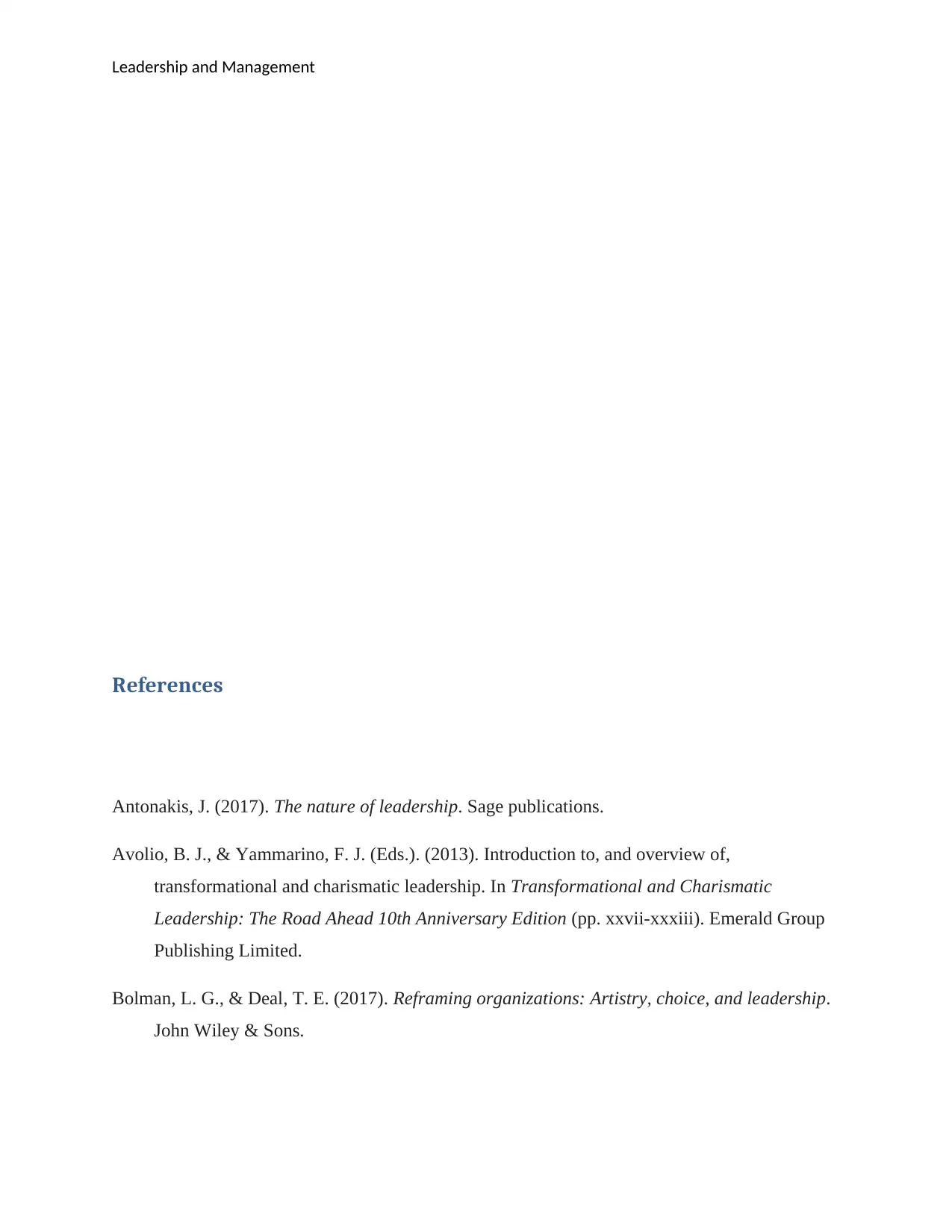
Leadership and Management
References
Antonakis, J. (2017). The nature of leadership. Sage publications.
Avolio, B. J., & Yammarino, F. J. (Eds.). (2013). Introduction to, and overview of,
transformational and charismatic leadership. In Transformational and Charismatic
Leadership: The Road Ahead 10th Anniversary Edition (pp. xxvii-xxxiii). Emerald Group
Publishing Limited.
Bolman, L. G., & Deal, T. E. (2017). Reframing organizations: Artistry, choice, and leadership.
John Wiley & Sons.
References
Antonakis, J. (2017). The nature of leadership. Sage publications.
Avolio, B. J., & Yammarino, F. J. (Eds.). (2013). Introduction to, and overview of,
transformational and charismatic leadership. In Transformational and Charismatic
Leadership: The Road Ahead 10th Anniversary Edition (pp. xxvii-xxxiii). Emerald Group
Publishing Limited.
Bolman, L. G., & Deal, T. E. (2017). Reframing organizations: Artistry, choice, and leadership.
John Wiley & Sons.
Paraphrase This Document
Need a fresh take? Get an instant paraphrase of this document with our AI Paraphraser
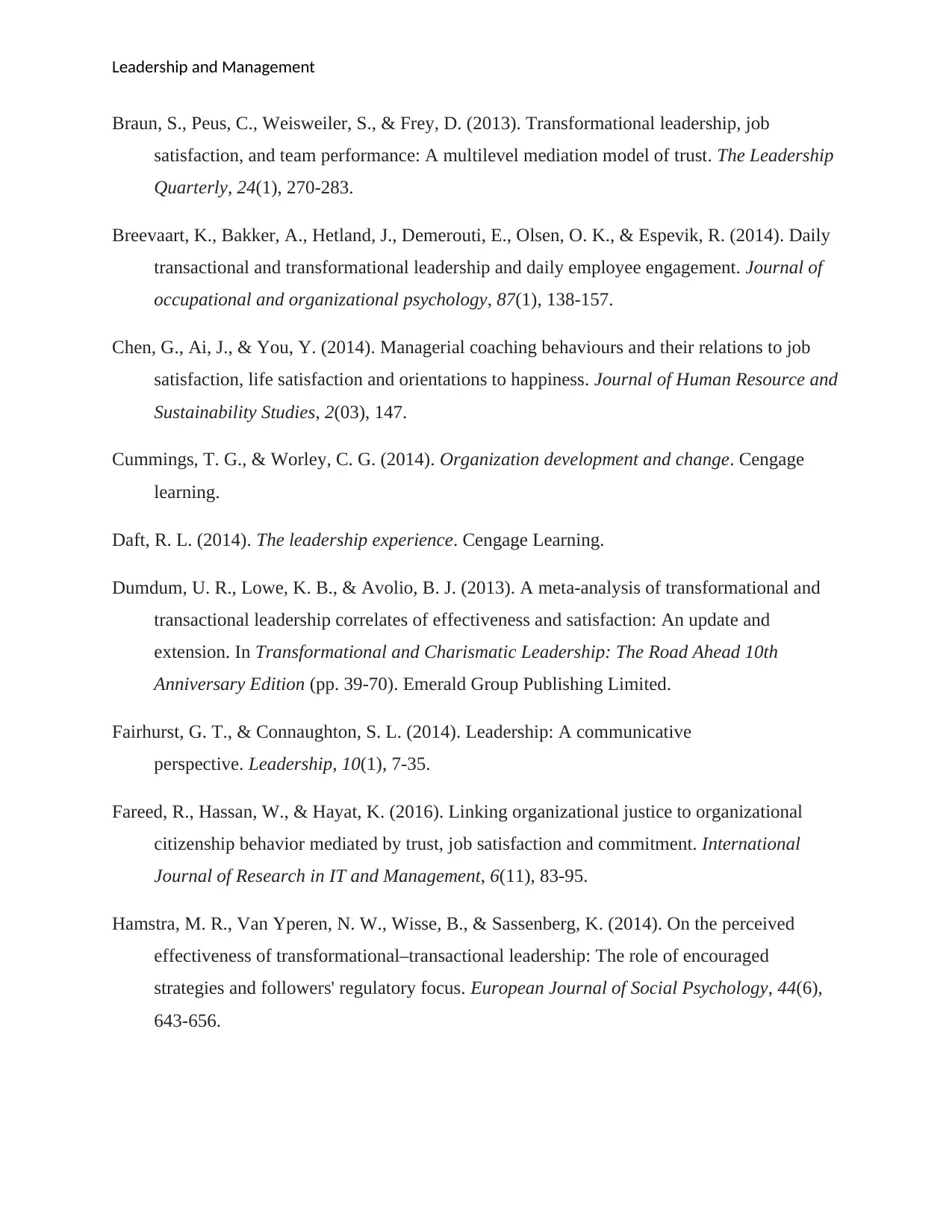
Leadership and Management
Braun, S., Peus, C., Weisweiler, S., & Frey, D. (2013). Transformational leadership, job
satisfaction, and team performance: A multilevel mediation model of trust. The Leadership
Quarterly, 24(1), 270-283.
Breevaart, K., Bakker, A., Hetland, J., Demerouti, E., Olsen, O. K., & Espevik, R. (2014). Daily
transactional and transformational leadership and daily employee engagement. Journal of
occupational and organizational psychology, 87(1), 138-157.
Chen, G., Ai, J., & You, Y. (2014). Managerial coaching behaviours and their relations to job
satisfaction, life satisfaction and orientations to happiness. Journal of Human Resource and
Sustainability Studies, 2(03), 147.
Cummings, T. G., & Worley, C. G. (2014). Organization development and change. Cengage
learning.
Daft, R. L. (2014). The leadership experience. Cengage Learning.
Dumdum, U. R., Lowe, K. B., & Avolio, B. J. (2013). A meta-analysis of transformational and
transactional leadership correlates of effectiveness and satisfaction: An update and
extension. In Transformational and Charismatic Leadership: The Road Ahead 10th
Anniversary Edition (pp. 39-70). Emerald Group Publishing Limited.
Fairhurst, G. T., & Connaughton, S. L. (2014). Leadership: A communicative
perspective. Leadership, 10(1), 7-35.
Fareed, R., Hassan, W., & Hayat, K. (2016). Linking organizational justice to organizational
citizenship behavior mediated by trust, job satisfaction and commitment. International
Journal of Research in IT and Management, 6(11), 83-95.
Hamstra, M. R., Van Yperen, N. W., Wisse, B., & Sassenberg, K. (2014). On the perceived
effectiveness of transformational–transactional leadership: The role of encouraged
strategies and followers' regulatory focus. European Journal of Social Psychology, 44(6),
643-656.
Braun, S., Peus, C., Weisweiler, S., & Frey, D. (2013). Transformational leadership, job
satisfaction, and team performance: A multilevel mediation model of trust. The Leadership
Quarterly, 24(1), 270-283.
Breevaart, K., Bakker, A., Hetland, J., Demerouti, E., Olsen, O. K., & Espevik, R. (2014). Daily
transactional and transformational leadership and daily employee engagement. Journal of
occupational and organizational psychology, 87(1), 138-157.
Chen, G., Ai, J., & You, Y. (2014). Managerial coaching behaviours and their relations to job
satisfaction, life satisfaction and orientations to happiness. Journal of Human Resource and
Sustainability Studies, 2(03), 147.
Cummings, T. G., & Worley, C. G. (2014). Organization development and change. Cengage
learning.
Daft, R. L. (2014). The leadership experience. Cengage Learning.
Dumdum, U. R., Lowe, K. B., & Avolio, B. J. (2013). A meta-analysis of transformational and
transactional leadership correlates of effectiveness and satisfaction: An update and
extension. In Transformational and Charismatic Leadership: The Road Ahead 10th
Anniversary Edition (pp. 39-70). Emerald Group Publishing Limited.
Fairhurst, G. T., & Connaughton, S. L. (2014). Leadership: A communicative
perspective. Leadership, 10(1), 7-35.
Fareed, R., Hassan, W., & Hayat, K. (2016). Linking organizational justice to organizational
citizenship behavior mediated by trust, job satisfaction and commitment. International
Journal of Research in IT and Management, 6(11), 83-95.
Hamstra, M. R., Van Yperen, N. W., Wisse, B., & Sassenberg, K. (2014). On the perceived
effectiveness of transformational–transactional leadership: The role of encouraged
strategies and followers' regulatory focus. European Journal of Social Psychology, 44(6),
643-656.
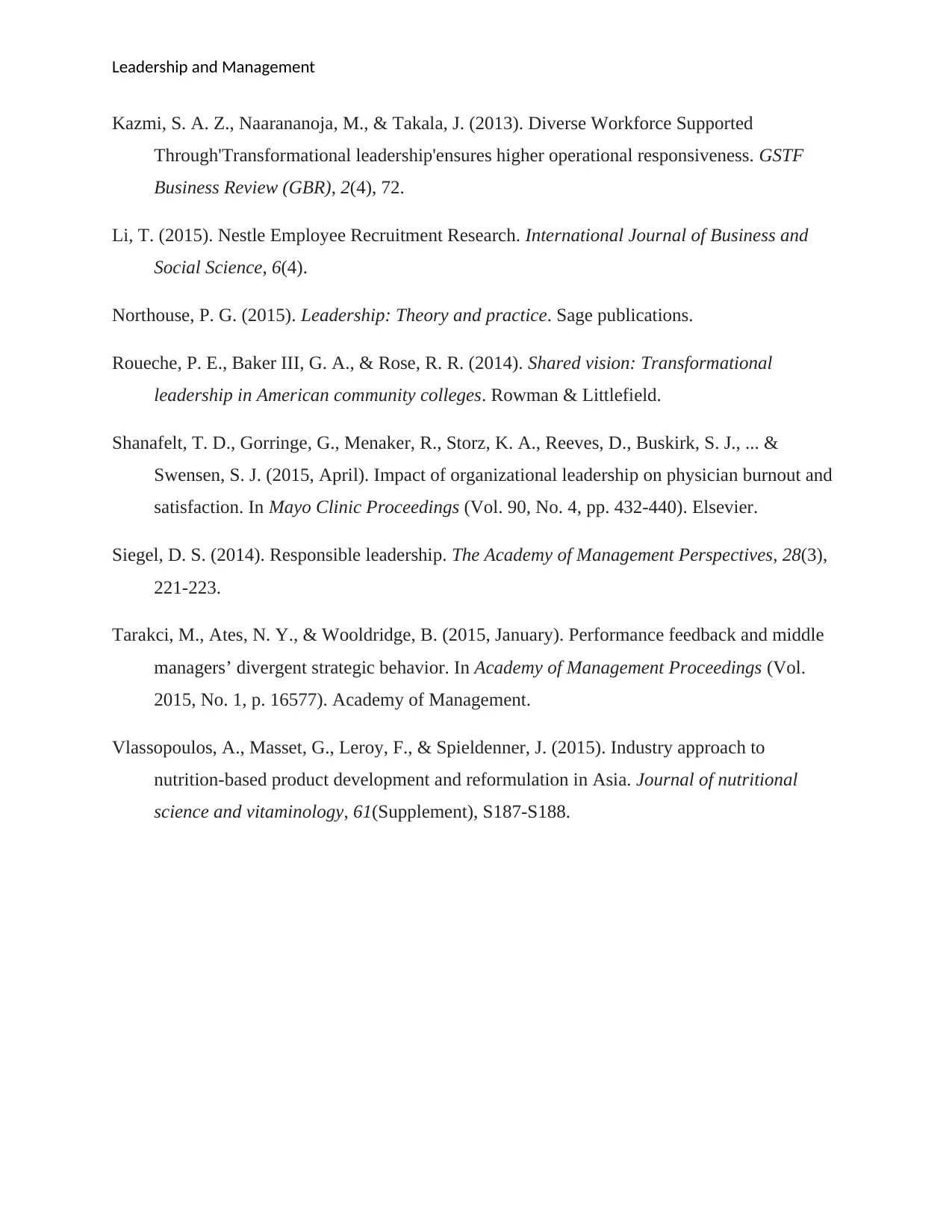
Leadership and Management
Kazmi, S. A. Z., Naarananoja, M., & Takala, J. (2013). Diverse Workforce Supported
Through'Transformational leadership'ensures higher operational responsiveness. GSTF
Business Review (GBR), 2(4), 72.
Li, T. (2015). Nestle Employee Recruitment Research. International Journal of Business and
Social Science, 6(4).
Northouse, P. G. (2015). Leadership: Theory and practice. Sage publications.
Roueche, P. E., Baker III, G. A., & Rose, R. R. (2014). Shared vision: Transformational
leadership in American community colleges. Rowman & Littlefield.
Shanafelt, T. D., Gorringe, G., Menaker, R., Storz, K. A., Reeves, D., Buskirk, S. J., ... &
Swensen, S. J. (2015, April). Impact of organizational leadership on physician burnout and
satisfaction. In Mayo Clinic Proceedings (Vol. 90, No. 4, pp. 432-440). Elsevier.
Siegel, D. S. (2014). Responsible leadership. The Academy of Management Perspectives, 28(3),
221-223.
Tarakci, M., Ates, N. Y., & Wooldridge, B. (2015, January). Performance feedback and middle
managers’ divergent strategic behavior. In Academy of Management Proceedings (Vol.
2015, No. 1, p. 16577). Academy of Management.
Vlassopoulos, A., Masset, G., Leroy, F., & Spieldenner, J. (2015). Industry approach to
nutrition-based product development and reformulation in Asia. Journal of nutritional
science and vitaminology, 61(Supplement), S187-S188.
Kazmi, S. A. Z., Naarananoja, M., & Takala, J. (2013). Diverse Workforce Supported
Through'Transformational leadership'ensures higher operational responsiveness. GSTF
Business Review (GBR), 2(4), 72.
Li, T. (2015). Nestle Employee Recruitment Research. International Journal of Business and
Social Science, 6(4).
Northouse, P. G. (2015). Leadership: Theory and practice. Sage publications.
Roueche, P. E., Baker III, G. A., & Rose, R. R. (2014). Shared vision: Transformational
leadership in American community colleges. Rowman & Littlefield.
Shanafelt, T. D., Gorringe, G., Menaker, R., Storz, K. A., Reeves, D., Buskirk, S. J., ... &
Swensen, S. J. (2015, April). Impact of organizational leadership on physician burnout and
satisfaction. In Mayo Clinic Proceedings (Vol. 90, No. 4, pp. 432-440). Elsevier.
Siegel, D. S. (2014). Responsible leadership. The Academy of Management Perspectives, 28(3),
221-223.
Tarakci, M., Ates, N. Y., & Wooldridge, B. (2015, January). Performance feedback and middle
managers’ divergent strategic behavior. In Academy of Management Proceedings (Vol.
2015, No. 1, p. 16577). Academy of Management.
Vlassopoulos, A., Masset, G., Leroy, F., & Spieldenner, J. (2015). Industry approach to
nutrition-based product development and reformulation in Asia. Journal of nutritional
science and vitaminology, 61(Supplement), S187-S188.
⊘ This is a preview!⊘
Do you want full access?
Subscribe today to unlock all pages.

Trusted by 1+ million students worldwide
1 out of 15
Related Documents
Your All-in-One AI-Powered Toolkit for Academic Success.
+13062052269
info@desklib.com
Available 24*7 on WhatsApp / Email
![[object Object]](/_next/static/media/star-bottom.7253800d.svg)
Unlock your academic potential
Copyright © 2020–2025 A2Z Services. All Rights Reserved. Developed and managed by ZUCOL.




